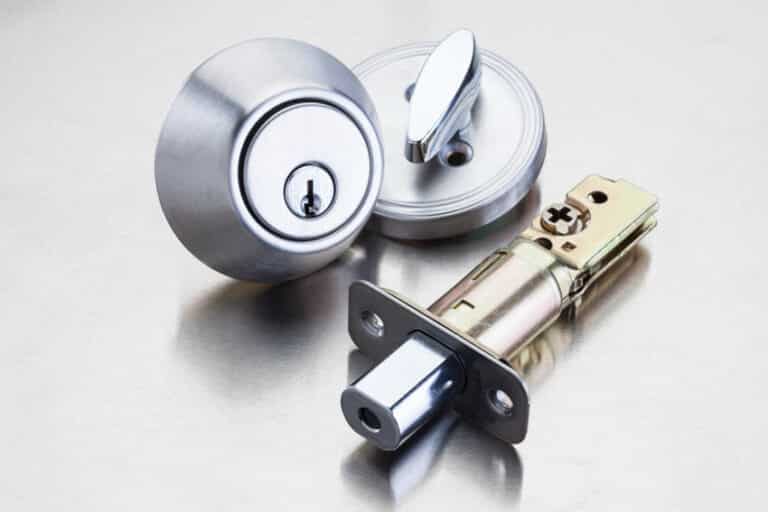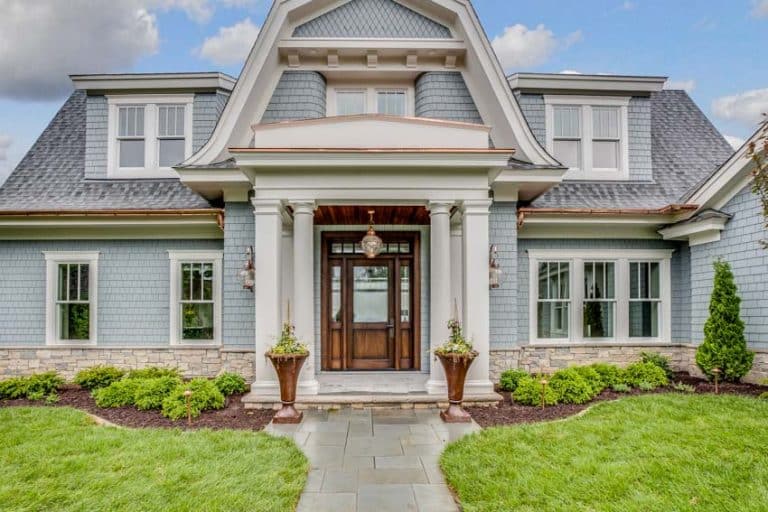10 Types Of Chimney Liners (Styles & Sizes)
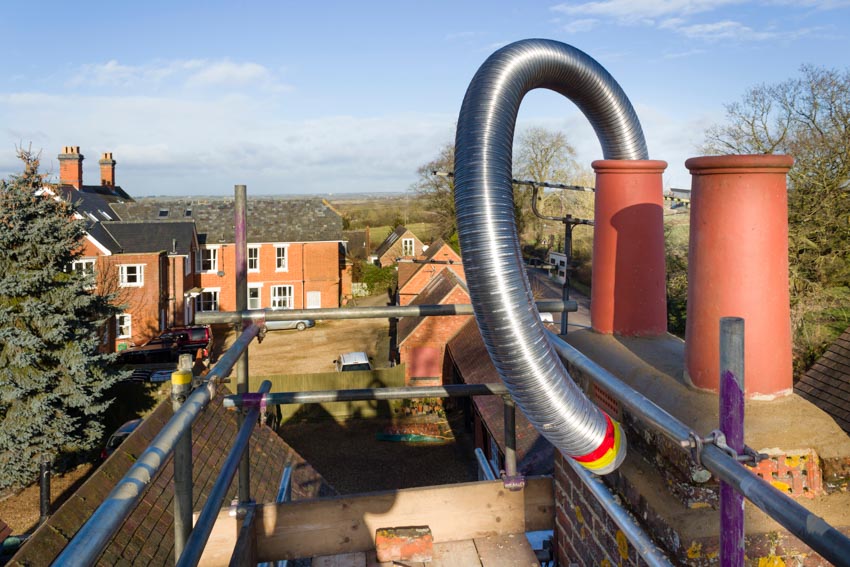
Not all homes have chimneys but for those that do, you will need specific care and maintenance to make the most of this element in your home. Many old homes come with chimneys without lining despite it being a requirement as early as the 1900s. The U.S. National Bureau of Standards or NBS also deemed chimneys without liners extremely dangerous 75 years ago.
NBS believes that a chimney without lining is an unsafe practice that can lead to dangerous situations and can be labeled as practically criminal. If you’ve bought an old home that comes with a chimney without liners, are building a chimney, or need to replace a liner, its important to know its best usage.
What Is a Chimney Liner?
As early as the 1900s, chimney liners became part of the building code requirements in the United States. The problem is that many modern builders choose to ignore these practices and skip this part of the process. And this can lead to very dangerous situations in the long run.
According to the Chimney Safety Institute of America, a chimney liner is a lining, made of ceramic, clay, or metal conduit, installed and “lined” inside a chimney in order to contain all combustion that may occur.
The heat will be directed outside of the home in order to protect your chimney and walls from corrosion and heat. This will serve as a barrier for your home against heat and gas and without it, your chimney can become a fire hazard.
Chimney liners can also help increase your chimney’s lifespan through their added protection. Its life can be significantly reduced when gasses penetrate the mortar and brick of the chimney, with the joints deteriorating and corroding because of this gas leak. This means that installing chimney liners can increase the safety of your fireplace, home, and family.
Once you’ve installed chimney liners in your home, you and your home can benefit from them for 5 to 50 years of use. The lifespan of your chimney liner will depend on the material and type of chimney liners you use.
High-quality chimney liners also come with lifetime warranties so you can be protected if something goes wrong.
What Do Chimney Liners Look Like
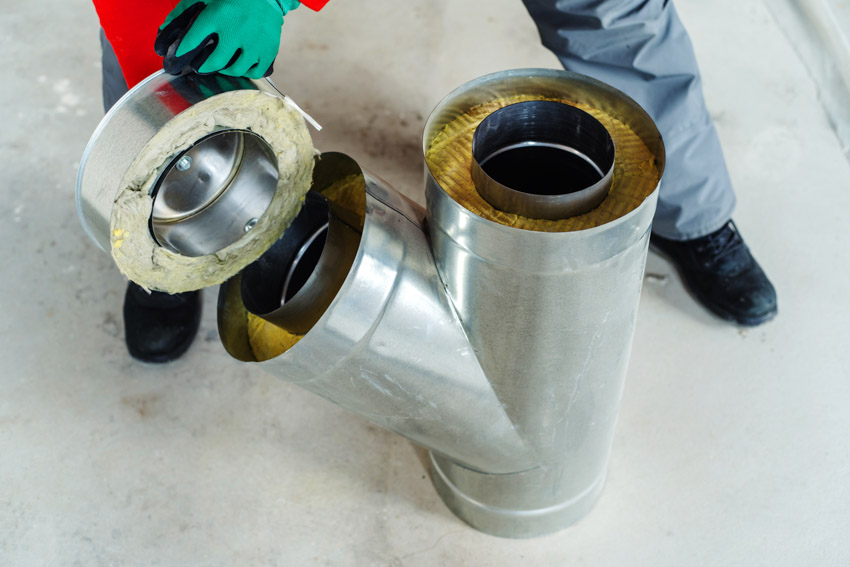
Checking if you have a chimney liner at home will be guaranteed if you have a professional inspect your chimney. But if you want to check for yourself, you need to know what a smokestack insulator looks like.
While these liners may differ in appearance based on the materials, you can check them out yourself. You can identify a liner in the chimney if there are clay tiles or metal rails inside. These liners are rounded or squared that run from the bottom of the chimney toward the top of the chimney, ending on the roof.
Clay Liner
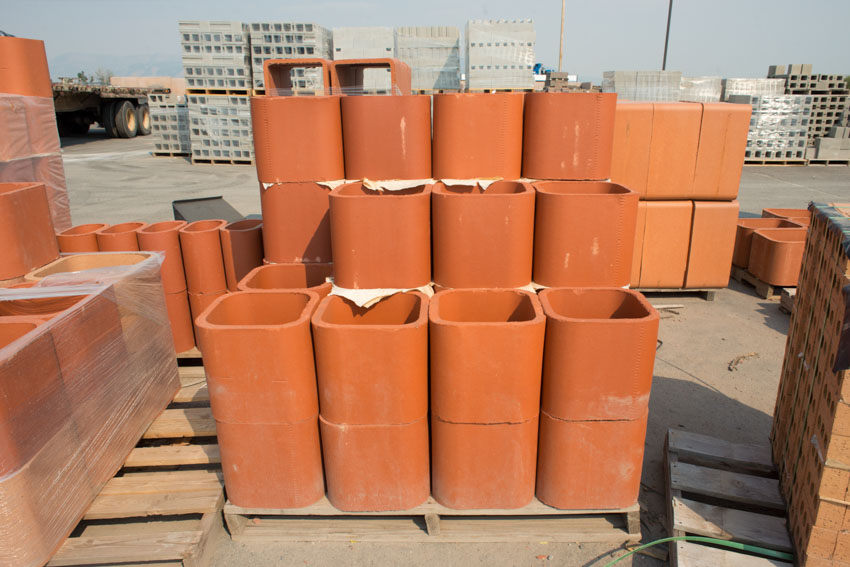
Type of Fuel: Wood
Cost: $10 per square foot
Considered the most universal type of chimney liners used in homes, clay chimney liners offer a great balance between quality and cost. It is a popular option because of how common it is and is easily available in the market. This type of liner works excellently well with an open chimney system.
Most old homes have clay tiles for their chimney liners since masons used clay in the past for chimneys of homes and buildings. Clay tile chimney liners are also known to unevenly distribute and not immediately absorb heat in the chimney fire. This can cause your clay tiles to split and fissure.
Clay Chimney Liners Uses: Clay tiles smokestack liners are ideal for fireplaces powered by pellets and wood as a fuel source. While it offers additional protection for wood heat, clay tile chimney liners are not ideal for oil or gas heating systems because of their vapors that can damage these clay liners.
When paired erroneously with gas or oil heating systems, these clay liners tend to deteriorate so quickly that you would be required to often repair or replace these tiles. So even if these are economical, they are not cost-effective since you need to pay for the repairs frequently.
They are however able to withstand regular wear and tear, as long as you pair this type of liner with the right kind of fuel source and heating systems.
Clay Chimney Liners Lifespan: Clay vent liners can last up to 50 years but the trick with this type of liner is that you should know how to use and make the most of it. You need to settle with wood and pellets for your fireplace but if you have a different heating system, you might also need to choose a different type of chimney liner.
Maintenance is also a big consideration and with clay chimney liners, you need to pay attention to cracks and splits since you would have to repair them as soon as you see them to avoid further paying for replacing the tiles.
Cast in Place Liner
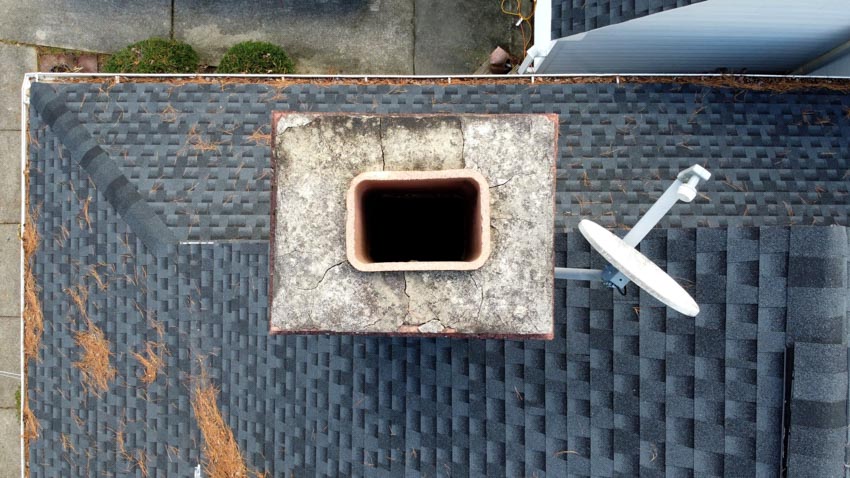
Type of Fuel: All Types of Fuel
Cost: $250 per square foot
Created over 60 years ago, cast in place flue liners became very popular when this type of flue liner was introduced. A lightweight, cast-in-place liner is a cement product that’s installed inside the smoke vent to provide an insulated and smooth passageway for the gasses.
Once installed, this liner becomes a permanent part of the chimney and can actually elevate its structural integrity and durability. Despite its popularity when they were first introduced, cast in place smokestack liners gained a negative image because of the high possibility of forming cracks, which can be very dangerous for your chimney and your home.
Another consideration to look into is the cost, which can be quite expensive for this type of chimney liner, especially since you’re going to need the help of a professional for its installation as well as its possible repair when cracking develops.
Cast In Place Chimney Liner Uses: When it comes to cast-in-place smokestack liners, you will pour the cement-like products inside the vent and along the outer walls, creating permanent stovepipe liners for your home. This means that you can use this if you want to have a permanent ventilation shaft liner for your home.
Besides that, it is also a good option if you want to improve the structural integrity of your home if either your clay chimney liner is already cracking or you are having some issues with the structure of your home.
Compatible with all fuel times, you won’t have to worry about matching the liner to a specific heating system but make sure that you’re set on having this liner for a lifetime since it’s a permanent addition to your chimney.
Cast In Place Chimney Liner Lifespan: Cast in place smokestack liners can last as long as 30 to 50 years and the specific number would depend on the type and quality of fuel you are burning, especially since cast in place chimney liners are compatible with all types of fuel.
Another important factor to consider is the structural condition of your chimney. Considering this liner will be a permanent element in your vent and home, the status of a home will be a big factor in how long the smokestack liner will last.
Aluminum Liner
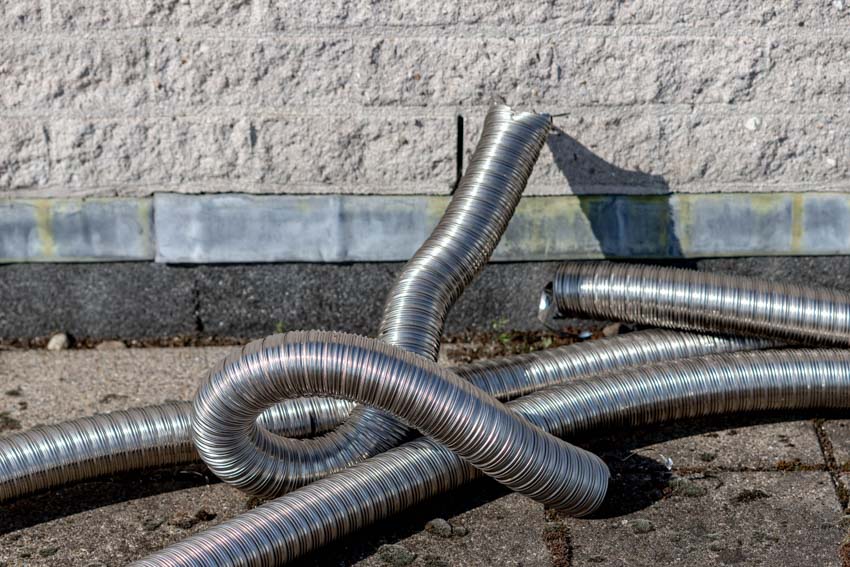
Type of Fuel: Natural Gas or Propane
Cost: $12 per square foot
Considered the most affordable type of flue liner you can use, aluminum flue liners are the cheaper version of their stainless counterpart. Not as versatile as stainless steel, aluminum liners are best used for a medium-efficiency gas system. Insulation is a must for metal liners like aluminum liners to ensure performance and safety.
With a melting point of 1215 degrees Fahrenheit, aluminum is commonly used to either repair or upgrade an existing chimney, similar to stainless steel. Many people go for aluminum smokestack liners in case of emergency, especially when there’s a lack of funds since this type of flue liner is the cheapest.
Aluminum Chimney Liner Uses: If you have an appliance with lower gas efficiency, aluminum vent liners may be an ideal choice. The deal with this type of vent liner is that you can only use them with certain types of appliances that they are approved of. This refers to appliances rated below 83 percent efficiency rating like older natural gas appliances and water heaters.
Aluminum Chimney Liner Lifespan: The drawback that comes with the most affordable smokestack liner is that it doesn’t last long compared to other types.
If you clean and maintain them properly and use them strictly for low to medium-efficiency gas appliances, aluminum smokestack liners can last around 10 to 15 years. If you somehow compromise its quality, its lifespan will significantly be reduced to 5 years, especially once the rusting starts.
Stainless Steel Liner
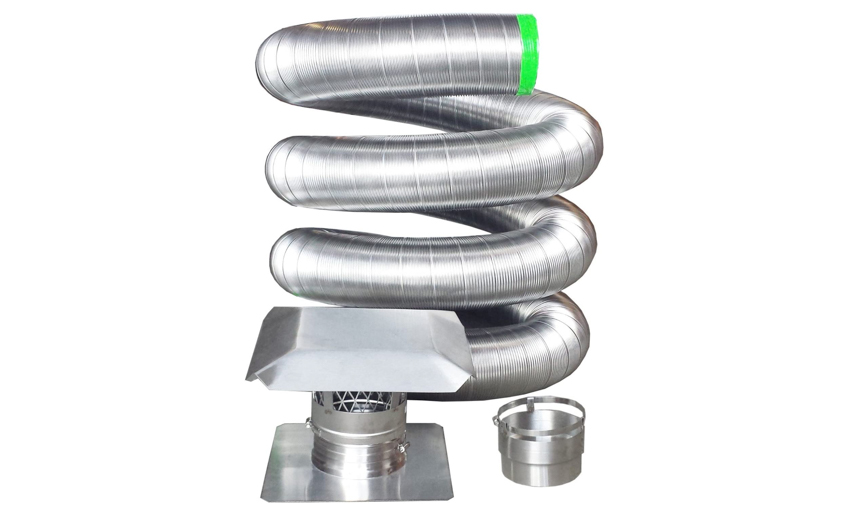
Type of Fuel: All Types of Fuel
Cost: $65 per square foot
The most popular metal smokestack liner is the stainless steel vent liner, especially with its flexibility since it can be used with all types of fuel, including gas, oil, and wood.
Usually comes with a lifetime warranty, this proves to show that manufacturers are willing to back the liner up and its durability. And with proper maintenance, these metal liners can actually outlast the structure of your home.
Stainless steel smokestack liners are the best option to upgrade your existing smokestack liner. Along with this liner though, high-temperature insulation is required to improve security and performance.
These liners come in a variety of sizes and shapes, making this type of liner very flexible. Installing a stainless steel vent liner for your home is also incredibly affordable, both for the materials and the installation.
Stainless Steel Chimney Liner Uses: Stainless steel smokestack liners can be used for all types of fuel so whatever fuel you use for your fireplace, you can install this type of flue liner. This is also the reason why it is the best option when updating your home’s heating system and appliances.
While they are not usually installed in new smokestack construction, they are the favorite option for relining specific types of chimneys and repairing and replacing existing liners. With repairs, these liners can easily be placed over damaged clay tiles.
And since most of them come with a lifetime warranty, you can save yourself from future maintenance costs. This makes the extra cost of stainless steel liners compared to clay liners worth it.
Stainless Steel Chimney Liner Lifespan: The best thing about stainless steel smokestack liners is that they are durable and can last for over 15 years. If you choose higher-end stainless steel liners and with proper cleaning and maintenance, they can last as long as 50 years.
And to even support that advantage, this liner usually comes with a lifetime warranty so in an event that you experience some issues with your liner that needs repair and replacement, you won’t need to worry about its cost.
Flexible Liners for Chimneys
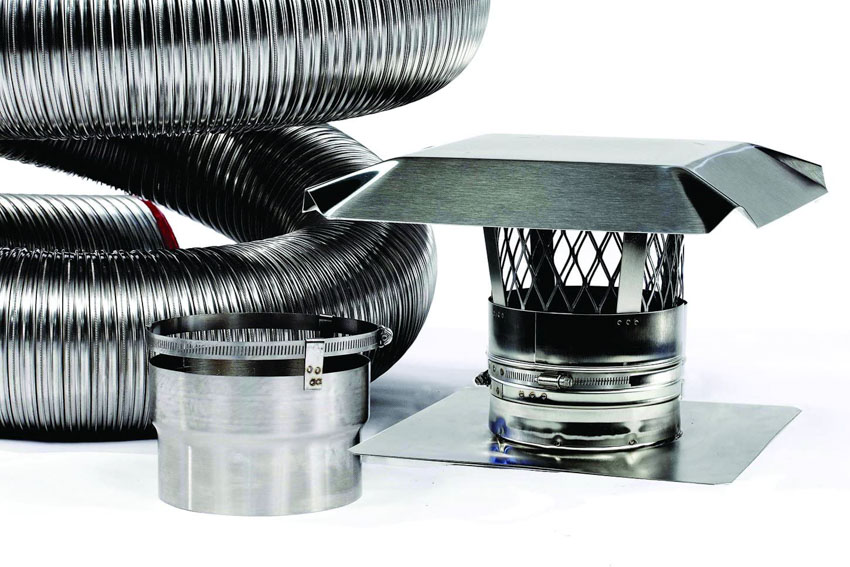
Flexibility can be regarded in different ways when it comes to flue liners but most would allude to their compatibility with different heating systems and types of fuels. A flexible smokestack liner is a type that can be used with all types of fuels, from gas to oil and wood.
And the most flexible fireplace duct liners you can consider are cast in place flue liners and stainless steel vent liners. Many homeowners would prefer cast in place fireplace duct liners for initial installation. However, stainless steel smokestack liners are most often used for relining and replacements.
Gas Fireplace Liners
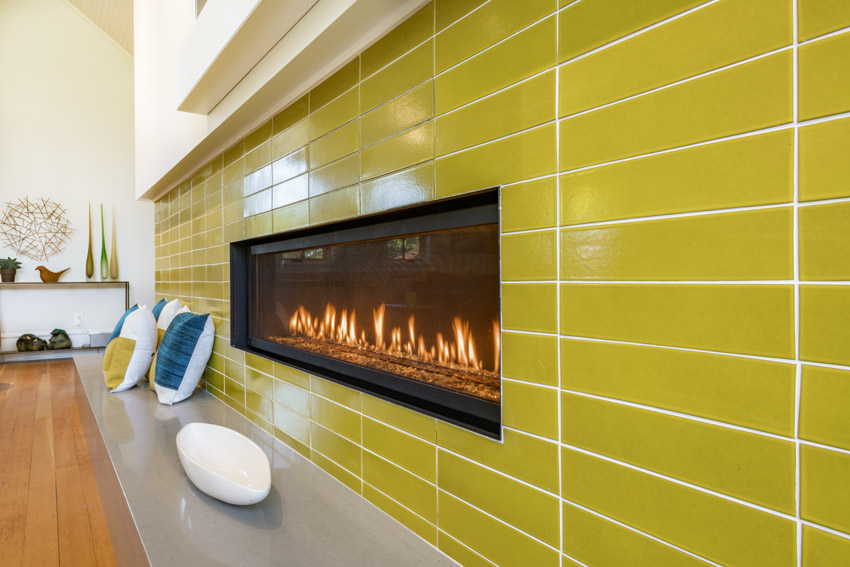
If you have a gas fireplace, clay tile flue liners just won’t do for you. The gasses can penetrate the tiles and cause damage and deterioration, which will happen most often in a gas fireplace and so you might be forced to repair and replace the tiles often too.
The good thing about having a gas fireplace though is that there are actually more options you can explore. You can consider cast in place and stainless steel flue liners since both can work well with this type of fireplace without getting damaged, unlike clay tile smokestack liners. Aluminum fireplace duct liners may be used for certain types of water heaters and gas furnaces but are not compatible with fireplaces.
Liners for Wood Burning Fireplaces
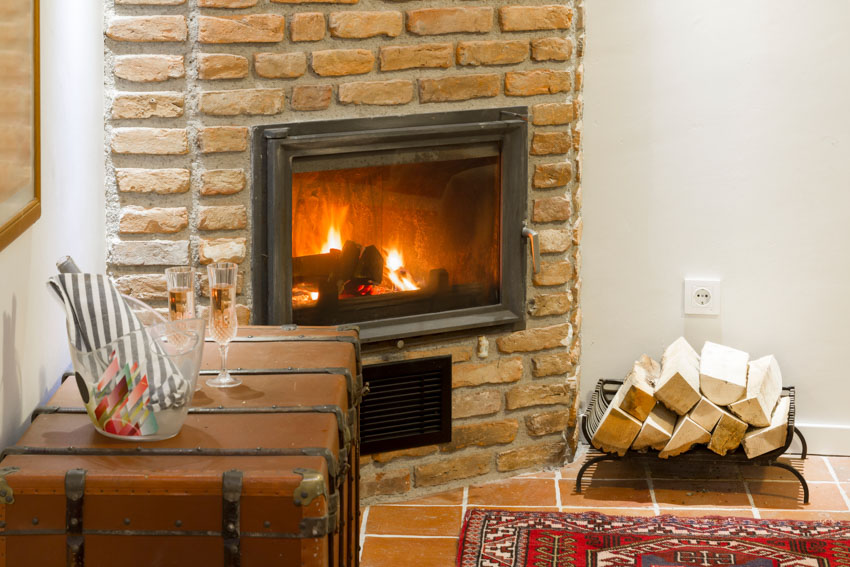
For a wood-burning fireplace, there will also be a specific type of flue liner that you need to consider. Traditionally, clay tile flue liners are used for a wood-burning fireplace but you always have the choice of choosing either a cast in place fireplace duct liner or stainless steel one.
Clay tile stack liners are built for regular wear and tear and can last for a long time. This is the same with the cast in place flue liners but clay tiles are more easily repaired and replaced if you need to repair your cast in place exhaust stack sleeve, your wood-burning fireplace will also be affected since this liner is a permanent addition to the structure.
Wood Stove Liners for Chimneys

The flue liners used for wood stoves are the same as the ones used for wood-burning fireplaces. The liners should be able to take the wear and tear of daily cooking so that they can last for a long time.
Clay tile smokestack liners, cast in place vent liners, and stainless steel fireplace duct liners can all work well with wood stoves. And just like for wood-burning fireplaces, aluminum exhaust stack sleeves would not be the best choice for these stoves.
Coal Stove Smokestack Flue Liners

A coal stove works the same way as a wood stove since it involves burning something to help you cook. The only difference is that while the former works with coals, the latter works with wood to keep the fire burning. In this case, you can use smokestack liners that work well with wood, including clay tiles, cast in place, and stainless steel stack liners.
Liners Used for Pellet Stove Chimneys
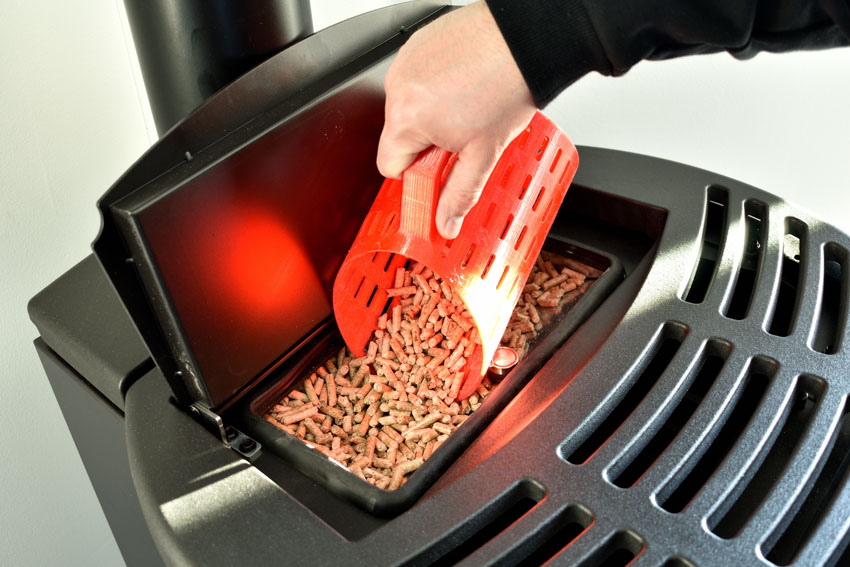
If you’re considering a pellet stove into your chimney, you would need to take into account the liner that will protect your smokestack and as a result your home and family.
While a pellet stove usually comes with an exhaust fan, this doesn’t mean that you won’t need a flue pipe lining anymore. If you already have an existing chimney, it works just fine but make sure that the smoke vent shield is compatible with your pellet stove.
Since this stove particularly uses wood, that’s where you can start choosing a flue pipe lining. And some of the compatible options you have are stainless, clay tiles, and cast in place exhaust stack sleeves since they work well with wood.
How Much Does a Liner for Chimney Cost?
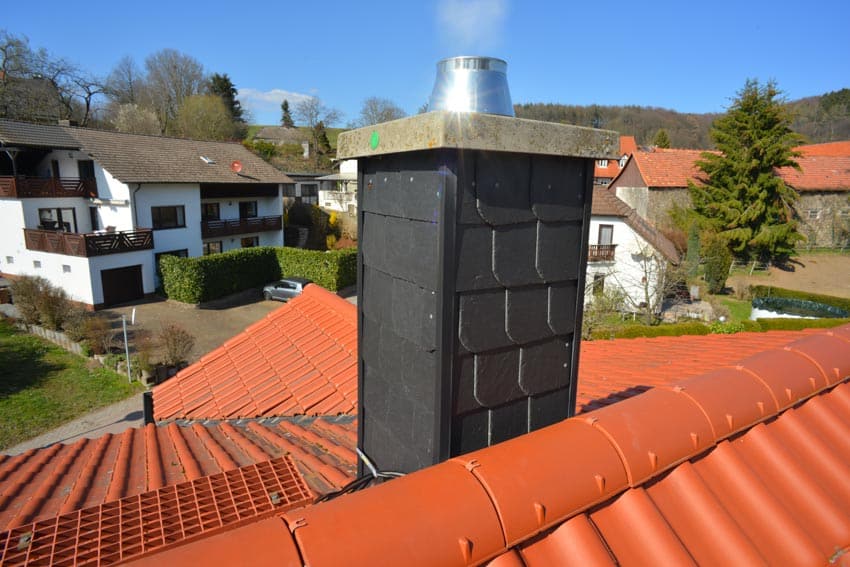
Fireplace lining cost different from each other, based on several factors including the material of the liner, the quality of the materials, the installation, and the added features you can include with your liners (E.g. insulation).
In general, the cost of a flue pipe lining project can range from $750 to $10,000, depending on different factors with the major ones being the materials used and the installation process.
If you choose to DIY the entire project, taking out the installation fees, expect to pay around $750 to $3,000, which mostly would consist of the materials. And if you’re depending on a professional to do the project for you, expect to pay $2,500 to $10,000.
If you’re planning to DIY your flue lining and want to know the cost of the materials that come with the different types of smoke vent shields, here is a quick look at their costs.
| Type of Chimney Liner | Cost (Materials Only) |
| Clay Chimney Liners | $10 per square foot |
| Cast In Place Chimney Liner | $250 per square foot |
| Aluminum Chimney Liner | $12 per square foot |
| Stainless Steel Stovepipe Sheathing | $65 to $100 per square foot |
The material you choose for your smoke vent shield will affect how much you will pay for it. The most affordable is the clay tiles but they cannot be used for oil and gas heating systems and they are labor-intensive to install.
The next affordable is the aluminum ventilation sheath and the most affordable metal option, but it’s also only limited to gas furnaces. Stainless steel can range from $65 to $100, depending on the quality of the stainless steel you choose.
This type of fire conduit protection also comes with a lifetime warranty to help you with the expenses in the case of maintenance. And finally, cast-in-place hearthpipe casings are an expensive option and become a permanent part of the structure of your chimney.
Liner Installation Cost

One of the most important considerations in a flue-lining project is the installation process. The installation cost relies heavily on the complexity of the project. Labor rates can range from $400 to $1,250, and there are times when it will take two to three professionals to work safely on the flue pipe lining.
Some of the services that come with exhaust stack sleeve installation include firebrick repair, damper replacement, and smoke chamber parging, which can cost around $2,500 to $7,000 in total.
Since the vent is hard to access, you will need to take into account the fees for a scaffold or a man lift, which may cost $500 per day. This also depends on the size of the home and if the experts include renting for this tool as part of hiring them or not.
Besides renting these tools that can help you install your fireplace duct encasements, you also have the option of paying for extra services, including brick repair and waterproofing. If you’re planning to make this your personal DIY project, you will need specific tools to complete this task successfully.
So while it can save you a lot to DIY this task, you need to already have the tools for the task. If not, buying or renting the tools you need for this project may cost you around $400 to $1,500.
Chimney Flue Liner Sizing Chart
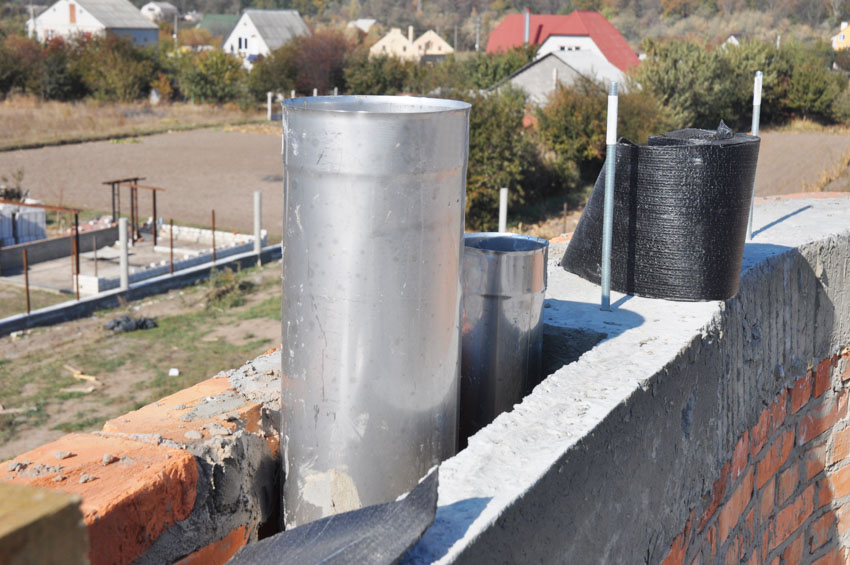
When working on a smokestack liner, it is vital to choose the correct size of liner suitable for your chimney, stove, or appliance. In order for the heating system to burn properly and accommodate insulation, the liner needs to have the right size to properly vent. When undersized, the liners can actually cause more harm, allowing smoke to go out of the stove, and the appliances to fail.
The ideal flue pipe lining diameter size depends on the outlet sizes of the appliance or stove. Besides not wanting an undersized liner, it should also not be three times bigger.
To serve as your guide here is a flue lining sizing chart you can reference:
| Fireplace Opening Size | Chimney Liner Diameter Needed |
| Up to 600 sq. in | 9 inches |
| 601 to 760 sq. in | 10 inches |
| 761 to 942 sq. in | 11 inches |
| 943 to 1,140 sq. in | 12 inches |
| 1,141 to 1,356 sq. in | 14 inches |
| 1,357 to 1,846 sq. in | 16 inches |
Get your tape measure and get the length of your chimney, from the top/crown to the opening where the stove or appliance is. Adding an extra two feet in the measurement is the ideal thing to do. For more related details, read about chimney cap sizes on this page.
Flue Liner Insulation
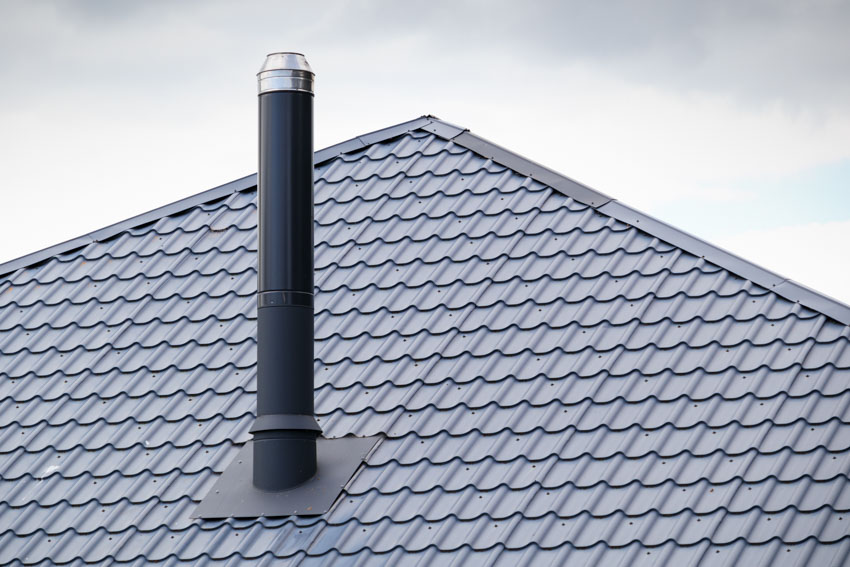
If you value the safety of your family, investing in the insulation of a ventilation sheath is the ideal thing to do. Some areas consider this mandatory while others see this as optional.
A flue insulator offers the following benefits:
• Improves the chimney’s draft ability
• Helps to reduce the condensation in the smokestack and build-up of corrosive materials and creosote
• Reduces how often the liners are to be drained
• Protects the chimney’s exterior masonry
• Helps the vent perform better and run more efficiently
Adding ventilation sheath insulation means that you would pay for around $200 to $1,500 depending on the material and type of flue lining involved.
When Is Chimney Relining Needed?
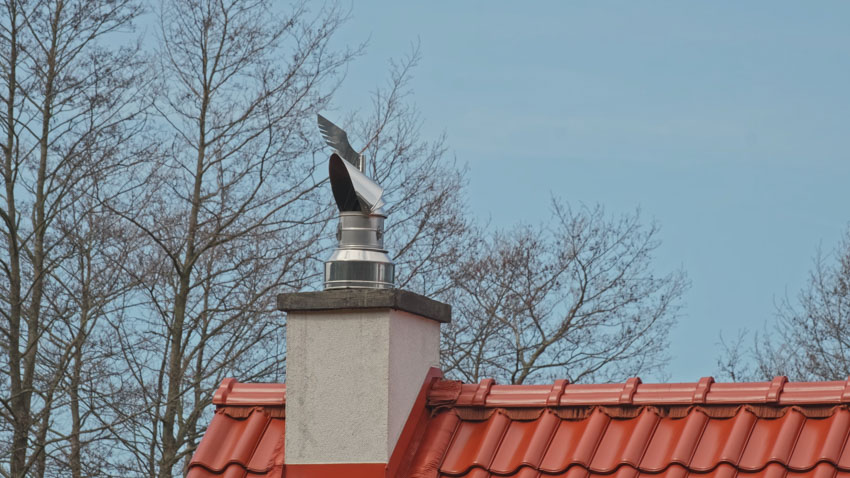
Draft pipe insulators serve as added protection to your chimney, home, and family, which makes them necessary. Flue relining will be needed for your home due to several possible causes.
Some of these include the following:
• No chimney liner
• Defective smoke vent shield
• Improper furnace vent envelope sizing
• Deteriorating chimney walls (Faster than usual)
• To provide protection against combustible parts
• Small cracks and breaches in the flue pipe lining
• Condensation in your chimney
• Fireplace update
The best thing you can do to be sure that you need smokestack relining is to have an expert check it out for you. A certified professional can easily know if there’s a problem in your fireplace duct and a need for relining.
The Connecticut State Department of Consumer Protection has a quick reference for steps to use before hiring a fireplace duct repair contractor for more details.
Chimney Lining Installation
The installation of a fire conduit protection ensures that your chimney, home, and family are safe as possible. If you choose to DIY this process, it’s important that you know everything about the twists and turns of this process.
Before you start with the installation process, there are specific steps to take as preparation, including the following:
• Step 1 – Chimney Checkup: Use a flashlight and survey your smokstack first for possible challenges you might encounter when installing the liner, from bends to restrictions.
• Step 2 – Take Measurements: Get a tape measure and measure the length of your chimney, from the opening inside your home and near the stove/appliance towards the top of the crown of the chimney. Don’t forget to measure the diameter of your chimney.
• Step 3 – Buy Your Smoke Vent Shield: Once you know the measurement of your chimney, you can now buy the liner you plan to install in your home. Check the sizing chart after you get the measurements. You can go for a stainless steel flue pipe lining if you want to be on the safe side.

Once you’re finished with all these preparations, you will proceed to the installation properly. To help you, here are simple and easy steps to follow when installing a flue pipe lining.
• Step 1 – Flatten the liner and officially start installing: Using a wrench, make sure to hook, fasten, and clamp the bottom connector to the bottom part of the liner. If you choose to add insulation, this is the best time to do so.
• Step 2 – Wrap the liner and secure the mesh: First, spray the adhesive on the liner and wrap foil tape around it until you completely cover the liner, and make sure to seal the seam. Roll about and hold the mesh in place.
• Step 3 – Attach the rope: Decide how you want to pull your liner through the fireplace duct and make sure to check the manufacturer’s manual if there’s a rope included in the ventilation sheath kit. Attach that rope to the bottom connector or pulling cone. Carefully get on the roof and get someone to assist you with feeding the liner into the chimney.
• Step 4 – Position the bottom connector: Throw the rope to the smokestack from the top, position the connected at the bottom center of the fireplace duct and start pulling until it’s in the correct position.
• Step 5 – Seal the crown of the chimney: Make sure that the liner is centered and then start sealing the fireplace duct crown using silicone caulking and press the top plate over the liner. Use screws to secure the quick-connect clamp around the liner.
• Step 6 – Attach the liner and connect it to the tee snout: Use the appliance connector to attach the liner to the bottom point.
Are Clay Liners Safe

Clay flue linings are the most common type of flue and are considered the traditional kind. They can be a safe option as long as you stick with what’s compatible with clay hearth pipe casing, which are wood and pellet stoves and fireplaces.
These clay fireplace duct encasements can be dangerous when used with gas fireplaces since vapors can penetrate the clay tiles, cause condensation, and lead to premature deterioration of the tiles.
You can expect it to last shorter than usual and you will need to check on it regularly just to be sure that the liner is still safe to use. See more related content in our article about the different types of chimney caps on this page.



